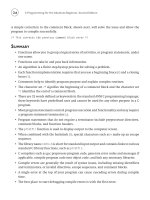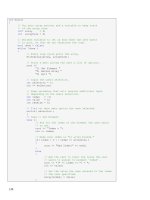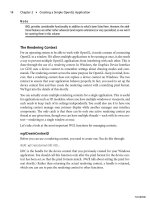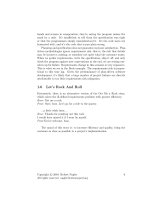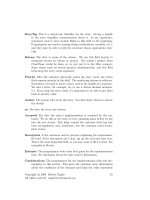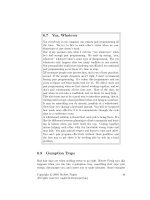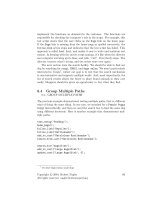Planning Extreme Programming - kent beck martin fowler phần 2 ppsx
Bạn đang xem bản rút gọn của tài liệu. Xem và tải ngay bản đầy đủ của tài liệu tại đây (71.1 KB, 15 trang )
20
plasm. It is clear that he will brook no discussion on this
matter.
Once silence has been restored, BB says: “We need to
begin immediately. How long will it take you to do the
analysis?"
You raise your hand. Your boss tries to stop you, but his
spitwad misses you and you are unaware of his efforts.
"Sir, we can't tell you how long the analysis will take until
we have some requirements."
"The requirements document won't be ready for three
or four weeks." BB says, his points vibrating with frustration.
"So, pretend that you have the requirements in front of
you now. How long will you require for analysis?"
No one breathes. Everyone looks around at everybody
else to see if they have some idea.
"If analysis takes any longer than April first, then we
have a problem. Can you finish the analysis by then?"
Your boss visibly gathers his courage building to the
ejaculation: "We'll find a way, sir!" His points grow 3mm;
and your headache increases by two Tylenol.
"Good." BB Smiles. "Now, how long will it take to do the
design?"
"Sir," you say. Your boss visibly pales. He is clearly worried
that his 3mms are at risk. "Without an analysis, it will not be
possible to tell you how long design will take."
BB's expression shifts beyond austere. "PRETEND, you
have the analysis already!" He says, while fixing you with
his vacant beady little eyes. "How long will it take you to
do the design?"
Two Tylenol are not going to cut it. Your boss, in a des-
perate attempt to save his new growth babbles: "Well, sir,
with only six months left to complete the project, design
had better take no longer than three months."
21
"I'm glad you agree, Smithers!" BB says, beaming. Your
boss relaxes. He knows his points are secure. After awhile
he starts lightly humming the Brylcream jingle.
BB continues, "So, analysis will be complete by April 1st,
Design will be complete by July 1st, and that gives you
three months to implement the project. This meeting is an
example of how well our new consensus and empower-
ment policies are working. Now, get out there and start
working. I'll expect to see TQM plans and QIT assignments
on my desk by next week. Oh, and don't forget your cross-
functional team meetings and reports will be needed for
next month’s quality audit."
"Forget the Tylenol." You think to yourself as you return
to your cubicle. "I need bourbon."
Visibly excited, your boss comes over to you and says,
"Gosh, what a great meeting. I think we're really going to
do some world shaking with this project." You nod in
agreement, too disgusted to do anything else.
"Oh," your boss continues, "I almost forgot." He hands
you a thirty page document. "Remember that the SEI are
coming to do an evaluation next week. This is the evalua-
tion guide. You need to read through it, memorize it, and
then shred it. It tells you how to answer any questions that
the SEI auditors ask you. It also tells you what parts of the
building you are allowed to take them to, and what parts
to avoid. We are determined to be a CMM level 3 organi-
zation by June!"
***
You and your peers start working on the analysis of the
new project. This is difficult because you have no require-
ments. But, from the 10-minute introduction given by BB
on that fateful morning, you have some idea of what the
product is supposed to do.
22
Corporate process demands that you begin by creat-
ing a use case document. You and your team begin enu-
merating use cases and drawing oval and stick diagrams.
Philosophical debates break out amongst the team.
There is disagreement as to whether certain use cases
should be connected with <<extends>> or <<includes>>
relationships. Competing models are created, but
nobody knows how to evaluate them. The debate contin-
ues, effectively paralyzing progress.
After a week, somebody finds the iceberg.com web-
site that recommends disposing entirely of <<extends>>
and <<includes>> and replacing them with <<pre-
cedes>> and <<uses>>. The documents on this website,
authored by Don Sengroiux, describes a method known
as Stalwart-analysis which claims to be a step by step
method for translating use-cases into design diagrams.
More competing use-case models are created using
this new scheme; but again, nobody agrees on how to
evaluate them. And the thrashing continues.
More and more, the use-case meetings are driven by
emotion rather than reason. If it weren’t for the fact that
you don’t have requirements, you’d be pretty upset by
the lack of progress you are making.
The requirements document arrives on the 15th of Feb-
ruary. And then again on the 20th, 25th, and every week
thereafter. Each new version contradicts the previous.
Clearly the marketing folks who are writing the require-
ments, empowered though they might be, are not finding
consensus.
At the same time, several new competing use-case
templates have been proposed by the various team
members. Each presents its own particularly creative way
of delaying progress. The debates rage on.
23
On March 1st, Percival Putrigence, the process proctor,
succeeds in integrating all the competing use-case forms
and templates into a single, all-encompassing form. Just
the blank form is fifteen pages long. He has managed to
include every field that appeared on all the competing
templates. He also presents a 159 page document
describing how to fill out the use-case form. All current use
cases must be rewritten according to the new standard.
You marvel to yourself that it now requires fifteen pages
of fill-in-the-blank, and essay questions, to answer the
question: “What should the system do when the user hit’s
return.”
The corporate process (authored by L. E. Ott, famed
author of “Holistic analysis: A progressive dialectic for soft-
ware engineers.”) insists that you discover all primary use-
cases, 87% of all secondary use cases, and 36.274% of all
tertiary use cases before you can complete analysis and
enter the design phase. You have no idea what a tertiary
use-case is. So in an attempt to meet this requirement you
try to get your use-case document reviewed by the mar-
keting department. Maybe they know what a tertiary
use-case is.
Unfortunately the marketing folks are too busy with
sales support to talk to you. Indeed, since the project
started, you have not been able to get a single meeting
with marketing. The best they have been able to do is
provide a never ending stream of changing and contra-
dictory requirements documents.
While one team has been spinning endlessly on the
use-case document, another has been working out the
domain model. Endless variations of UML documents are
pouring out of this team. Every week the model is
reworked. The team members can’t decide on whether
24
to use <<interfaces>> or <<types>> in the model. A huge
disagreement has been raging on the proper syntax and
application of OCL. Other’s in the team just got back
from a five day class on “catabolism”, and have been
producing incredibly detailed and arcane diagrams that
nobody else can fathom.
On March 27th, with one week to go before analysis is
to be complete, you have produced a sea of documents
and diagrams; but are no closer to a cogent analysis of
the problem than you were on January third.
•••
And then, a miracle happens.
•••
On Saturday, April 1st you check you email from home.
You see a memo from your boss to BB. It states unequivo-
cally that you are done with the analysis!
You phone your boss and complain. "How could you
have told BB that we were done with the analysis?"
"Have you looked at a calendar lately?” he responds,
“It's April 1st!"
The irony of that date does not escape you. "But we
have so much more to think about. So much more to
analyze!, we haven’t even decided whether to use
<<extends>> or <<precedes>>!"
"Where is your evidence that you are not done?"
inquires your boss impatiently.
"Whaaa "
But he cuts you off. "Analysis can go on forever, it has to
be stopped at some point. And since this is the date it
was scheduled to stop, it has been stopped. Now, on
Monday I want you to gather up all existing analysis
materials and put them into a public folder. Release that
25
folder to Percival so that he can log it in the CM system by
Monday afternoon. Then get busy and start designing."
As you hang up the phone, you begin to consider the
benefits of keeping a bottle of bourbon in your bottom
desk drawer.
***
They threw a party to celebrate the on-time comple-
tion of the analysis phase. BB gave a colon stirring speech
on empowerment. And your boss, another 3mm taller,
congratulated his team on the incredible show of unity
and teamwork. Finally, the CIO takes the stage and tells
everyone that the SEI audit went very well, and thanks
everyone for studying and shredding the evaluation
guides that were passed out. Level three now seems
assured, and will be awarded by June.
(Scuttlebut has it that managers at the level of BB and
above are to receive significant bonuses once the SEI
awards level 3.)
As the weeks flow by, you and your team work on the
design of the system. Of course you find that the analysis
that the design is supposedly based upon is flawed no,
useless no, worse than useless. But when you tell your
boss that you need to go back and work some more on
the analysis to shore up its weaker sections, he simply
states: "The analysis phase is over. The only allowable
activity is design. Now get back to it."
So, you and your team hack the design as best you
can, unsure of whether the requirements have been
properly analyzed or not. Of course it really doesn't mat-
ter much since the requirements document is still thrash-
ing with weekly revisions, and the marketing department
still refuses to meet with you.
26
The design is a nightmare. Your boss recently mis-read
a book named “The Finish-line” in which the author, Mark
DeThomaso, blithely suggested that design documents
should be taken down to code level detail.
“If we are going to be working at that level of detail,”
you ask, “why don’t we just write the code instead?”
“Because then you wouldn’t be designing, of course.
And the only allowable activity in the design phase is
design!”
“Besides,” he continues, “we have just purchased a
company wide license for Dandylion! This tools enables
“Round the Horn Engineering!” You are to transfer all
design diagrams into this tool. It will automatically gener-
ate our code for us! It will also keep the design diagrams
in sync with the code!”
Your boss hands you a brightly colored shrink-wrapped
box containing the Dandylion distribution. You accept it
numbly, and shamble off to your cubicle. Twelve hours,
eight crashes, a disk reformatting, and eight shots of 151
later, you finally have the tool installed on your server. You
consider the week your team will lose while attending
Dandylion training. Then you smile and think, “Any week
I’m not here, is a good week.”
Design diagram after design diagram is created by
your team. Dandylion makes it very hard to draw these
diagrams. There are dozens and dozens of deeply nested
dialog boxes with funny text fields and check boxes that
must all be filled in correctly. And then there’s the prob-
lem of moving classes between packages
At first these diagram are driven from the use cases. But
the requirements are changing so often that the use-
cases rapidly become meaningless.
27
Debates rage about whether Visitor or Decorator
design patterns should be employed. One developer
refuses to use Visitor in any form claiming that it’s not a
properly object-oriented construct. Another refuses to
use multiple inheritance since it is the spawn of the devil.
Review meetings rapidly degenerate into debates
about the meaning of Object Orientation, the definition
of analysis vs. design, or when to use aggregation vs.
association.
Midway through the design cycle, the marketing folks
announce that they have rethought the focus of the sys-
tem. Their new requirements document is completely
restructured. They have eliminated several major feature
areas, and replaced them with feature areas that they
anticipate customer surveys will show to be more appro-
priate.
You tell your boss that these changes mean that you
need to reanalyze and redesign much of the system. But
he says: "The analysis phase is over. The only allowable
activity is design. Now get back to it.".
You suggest that it might be better to create a simple
prototype to show to the marketing folks, and even some
potential customers. But your boss says: "The analysis
phase is over. The only allowable activity is design. Now
get back to it.".
Hack, hack, hack, hack. You try to create some kind of
a design document that might actually reflect the new
requirements documents. However, the revolution of the
requirements has not caused them to stop thrashing.
Indeed, if anything, the wild oscillations of the require-
ments document have only increased in frequency and
amplitude. You slog your way through them.
28
On June 15th, the Dandylion database gets corrupted.
Apparently the corruption has been progressive. Small
errors in the DB accumulated over the months into bigger
and bigger errors. Eventually the CASE tool just stopped
working. Of course the slowly encroaching corruption is
present on all the backups.
Calls to the Dandylion technical support line go unan-
swered for several days. Finally you receive a brief email
from Dandylion, informing you that this is a known prob-
lem, and the solution is to purchase the new version
(which they promise will be ready some time next quar-
ter) and then re-enter all the diagrams by hand.
•••
Then, on July 1st another miracle happens! You are
done with the design!
Rather than go to your boss and complain, you stock
your middle desk drawer with some vodka.
***
They threw a party to celebrate the on-time comple-
tion of the design phase, and their graduation to CMM
level 3. This time you find BB's speech so stirring that you
have to use the restroom before it begins.
There are new banners and plaques all over your work-
place. They show pictures of eagles and mountain climb-
ers, and they talk about teamwork and empowerment.
They read better after a few scotches. That reminds you
that you need to clear out your file cabinet to make room
for the brandy.
You and your team begin to code. But you rapidly dis-
cover that the design is lacking in some significant areas.
Actually it’s lacking any significance at all. You convene a
design session in one of the conference rooms to try to
work through some of the nastier problems. But your boss
29
catches you at it and disbands the meeting saying: "The
design phase is over. The only allowable activity is coding.
Now get back to it."
The code generated by Dandylion is really hideous. It
turns out that you and your team were using association
and aggregation the wrong way after all. All the gener-
ated code has to be edited to correct these flaws. Edit-
ing this code is extremely difficult because it has been
instrumented with ugly comment blocks that have spe-
cial syntax that Dandylion needs in order to keep the dia-
grams in sync with the code. If you accidentally alter one
of these comments, then the diagrams will be regener-
ated incorrectly. It turns out that “Round the Horn Engi-
neering” requires an awful lot of effort.
The more you try to keep the code compatible with
Dandylion, the more errors Dandylion generates. In the
end, you give up and decide to keep the diagrams up to
date manually. A second later you decide there’s no
point in keeping the diagrams up to date at all. Besides,
who has time?
Your boss hires a consultant to build tools to count the
number of lines of code that are being produced. He
puts a big thermometer graph on the wall with the num-
ber 1,000,000 on the top. Every day he extends the red
line to show how many lines have been added.
Three days after the thermometer appears on the wall,
your boss stops you in the hall. "That graph isn't growing
fast enough. We need to have a million lines done by
October 1st."
"We aren't even sh-sh-shure that the proshect will
require a m-million linezh." You blather.
"We have to have a million lines done by October 1st."
your boss reiterates. His points have grown again, and the
30
Grecian formula he uses on them creates an aura of
authority and competence. "Are you sure your comment
blocks are big enough?"
Then, in a flash of managerial insight he says: "I have it! I
want you to institute a new policy amongst the engineers.
No line of code is to be longer than 20 characters. Any
such line must be split into two or more preferably more.
All existing code needs to be reworked to this standard.
That'll get our line count up!"
You decide not to tell him that this will require two
unscheduled man months. You decide not to tell him
anything at all. You decide that intravenous injections of
pure ethanol are the only solution. You make the appro-
priate arrangements.
Hack, hack, hack, and hack. You and your team madly
code away. By August 1st your boss, frowning at the ther-
mometer on the wall institutes a mandatory 50-hour work-
week.
Hack, hack, hack, and hack. By September 1st, the
thermometer is at 1.2 million lines and your boss asks you
to write a report describing why you exceeded the cod-
ing budget by 20%. He institutes mandatory Saturdays
and demands that the project be brought back down to
a million lines. You start a campaign of re-merging lines.
Hack, hack, hack, and hack. Tempers are flaring; peo-
ple are quitting; QA is raining trouble reports down on
you. Customers are demanding installation and user
manuals, salesmen are demanding advance demonstra-
tions for special customers; the requirements document is
still thrashing, the marketing folks are complaining that
the product isn’t anything like they specified, and the
liquor store won't accept your credit card anymore.
31
Something has to give. On September 15th BB calls a
meeting.
As he enters the room, his points are emitting clouds of
steam. When he speaks, the bass overtones of his care-
fully manicured voice cause the pit of your stomach to roll
over. "The QA manager has told me that this project has
less than 50% of the required features implemented. He
has also informed me that the system crashes all the time,
yields wrong results, and is hideously slow. He has also
complained that he cannot keep up with the continuous
train of daily releases; each more buggy than the last!"
He stops for a few seconds, visibly trying to compose
himself. "The QA manager estimates that, at this rate of
development, we won't be able to ship the product until
December!"
Actually, you think it's more like March, but you don't
say anything.
"December!" BB roars. People duck their heads as
though he were pointing an assault rifle at them. "Decem-
ber is absolutely out of the question. Team leaders, I want
new estimates on my desk in the morning. I am hereby
mandating 65-hour workweeks until this project is com-
plete. And it better be complete by Nov. 1st."
As he leaves the conference room he is heard to mut-
ter: "Empowerment - Bad!"
***
Your boss is bald; his points are mounted on BB's wall.
The fluorescent lights reflecting off his pate momentarily
dazzle you.
"Do you have anything to drink?" he asks. Having just
finished your last bottle of Boone's Farm, you pull a bottle
of Thunderbird from your bookshelf and pour it into his
32
coffee mug. "What's it going to take to get this project
done?" he asks.
"We need to freeze the requirements, analyze them,
design them, and then implement them." You say cal-
lously.
"By Nov. 1st?" your boss exclaims incredulously. "No way!
Just get back to coding the damned thing." He storms
out, scratching his vacant head.
A few days later you find that your boss has been trans-
ferred to the corporate research division. Turnover has
skyrocketed. Customers, informed at the last minute that
their orders cannot be fulfilled on time, have begun to
cancel their orders. Marketing is reevaluating whether or
not this product aligns with the overall goals of the com-
pany, etc., etc. Memos fly, heads roll, policies change,
and things are, overall, pretty grim.
Finally, by March, after far too many 65-hour weeks, a
very shaky version of the software is ready. In the field,
bug discovery rates are high, and the technical support
staff are at their wit's end trying to cope with the com-
plaints and demands of the irate customers. Nobody is
happy.
In April, BB decides to buy his way out of the problem
by licensing a product produced by Rupert industries and
redistributing it. The customers are mollified, the market-
ing folks are smug, and you are laid off.
Rupert
Rupert Industries. Project: ~Alpha~
Your name is Robert. The date is January 3rd, 2001. The
quiet hours spent with your family this holiday have left
you refreshed and ready for work. You are sitting in a con-
33
ference room with your team of professionals. The man-
ager of the division called the meeting.
“We have some ideas for a new project” says the divi-
sion manager. Call him Russ. He is a high strung British
chap with more energy than a fusion reactor. He is ambi-
tious and driven; but understands the value of a team.
Russ describes the essence of the new market opportu-
nity the company has identified, and introduces you to
Jay, the marketing manager who is responsible for defin-
ing the products that will address it.
Addressing you, Jay says: “We’d like to start defining
our first product offering as soon as possible. When can
you and you team meet with me?”
You reply: “We’ll be done with the current iteration of
our project this Friday. We can spare a few hours for you
between now and then. After that, we’ll take a few peo-
ple from the team and dedicate them to you. We’ll begin
hiring their replacements, and the new people for your
team immediately.”
“Great”, says Russ, “But I want you to understand that it
is critical that we have something to exhibit at the trade
show coming up this July. If we can’t be there with some-
thing significant, we’ll lose the opportunity.”
“I understand.” you reply. “I don’t yet know what it is
that you have in mind, but I’m sure we can have some-
thing by July. I just can’t tell you what that something will
be right now. In any case, you and Jay are going to have
complete control over what we developers do, so you
can rest assured that by July you’ll have the most impor-
tant things that can be accomplished in that time ready
to exhibit.”
Russ nods in satisfaction. He knows how this works. Your
team has always kept him advised and allowed him to
steer their development. He has the utmost confidence
that your team will work on the most important things first;
and that they will produce a high quality product.
~ ~ ~
“So Robert,” says Jay at their first meeting, “How does
your team feel about being split up?”
“We’ll miss working with each other”, you answer, “but
some of were getting pretty tired of that last project and
34
are looking forward to a change. So, what are you guys
cooking up?”
Jay beams. “You know how much trouble our custom-
ers currently have ” And he spends a half hour or so
describing the problem and possible solution.
“OK, wait a second” you respond. “I need to be clear
about this.” And so you and Jay talk about how this sys-
tem might work. Some of Jay’s ideas aren’t fully formed.
You suggest possible solutions. He likes some of them. You
continue discussing.
During the discussion, as each new topic is addressed,
Jay writes user story cards. Each card represents some-
thing that the new system has to do. The cards accumu-
late on the table and are spread out in front of you. Both
you and Jay point at them, and pick them up, and make
notes on them as you discuss the stories. The cards are
powerful mnemonic devices that you can use to repre-
sent complex ideas that are barely formed.
At the end of the meeting you say: “OK, I’ve got a gen-
eral idea of what you want. I’m going to talk to the team
about it. I imagine there are some experiments they’ll
want to run with various database structures and presen-
tation formats. Next time we meet, it’ll be as a group, and
we’ll start identifying the most important features of the
system.
A week later your nascent team meets with Jay. They
spread the existing user story cards out on the table and
begin to get into some of the details of the system.
The meeting is very dynamic. Jay presents the stories in
the order of their importance. There is much discussion
about each one. The developers are concerned about
keeping the stories small enough to estimate and test. So
they continually ask Jay to split one story into several
smaller stories. Jay is concerned that each story has a
clear business value and priority, so as he splits them, he
makes sure this stays true.
The stories accumulate on the table. Jay writes them,
but the developers make notes on them as needed.
Nobody tries to capture everything that is said; the cards
are not meant to capture everything; they are just
reminders of the conversation.
